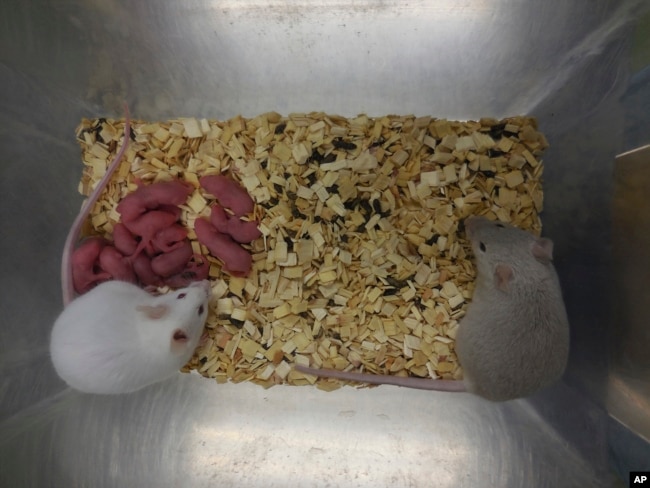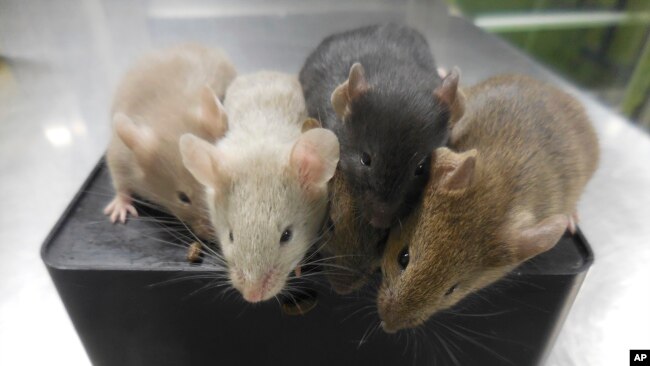驚きのニュースです!!
まだこれからですが、絶滅危惧種の動物を1匹のオスから繁殖させることができるようになるかもしれないという希望を見せてくれました。
VOAで英語を学びましょう!!
2匹の雄から採取した細胞でマウスを初めて作製(和訳)
For First Time, Scientists Create Mice with Cells from Two Males
幹細胞とは、発達の初期にある細胞で、他のどんな種類の細胞にも発展することができます。
そして最後に、その卵をfertilize受精させ、胚を雌のマウスに移植しました。その結果、630個中7個という約1パーセントの胚が、生きた赤ちゃんマウスに成長しました。
この研究を主導したのは、日本の九州大学と大阪大学のハヤシ・カツヒロ 氏です。
彼は今月初めに開催された第3回ヒトゲノム編集に関する国際サミットで、仲間の科学者たちとともに講演しました。ハヤシ氏によれば、マウスの赤ちゃんは正常に成長し、通常の方法で自分も親になることができたと言います。
For First Time, Scientists Create Mice with Cells from Two Males
For the first time, scientists have created baby mice with two fathers. They did this by turning mouse stem cells into female cells in a lab.
Stem cells are cells early in their development that can develop into any other kind of cell.
The result raises the distant possibility of doing the same for people. But experts say very few mouse embryos were born alive. They add that no one knows if the same method would work in human stem cells.
Diana Laird is a stem cell and reproductive expert at the University of California, San Francisco. She was not involved with the research. She said the researchers developed a very smart method for changing male stem cells to female stem cells. She added, “It’s an important step in both stem cell and reproductive biology.”
Scientists described their work in a study published last week in the journal Nature.
First, the researchers took skin cells from the tails of male mice and changed them into a kind of stem cell called “induced pluripotent stem cells.” These cells can develop into many different kinds of cells or tissues. Then, they turned the male mouse stem cells into female cells and produced functional egg cells. They did this through a process that involved growing the stem cells and treating them with a drug.
Finally, they fertilized those eggs and placed the embryos into female mice. About one percent of the embryos – 7 out of 630 – grew into live baby mice.
Katsuhiko Hayashi of Kyushu University and Osaka University in Japan led the research. He spoke with fellow scientists at the Third International Summit on Human Genome Editing earlier this month. He said the baby mice appear to grow normally and were able to become parents themselves in the usual way.
Jonathan Bayerl works with Laird. The two scientists said in an article published alongside the Nature study that the work “opens up new avenues in reproductive biology and fertility research” for animals and people. In the future, for example, it might be possible to reproduce endangered animals from a single male.
But they also raised several possible problems. The largest one is that the method is extremely inefficient. They said it is unclear why such a small number of the embryos placed into the female mice survived. The reasons could be technical or biological. They also said it is too early to know if the method would work in human stem cells at all.
Laird added that scientists need to be careful of the mutations and mistakes that may be introduced in the method before using stem cells to make eggs.
The research is the latest to test new ways to create mouse embryos in the lab.
Last summer, scientists in California and Israel created mouse embryos from stem cells without the beginning cells needed for reproduction or uterus. Those embryos followed the development of natural mouse embryos up to eight and a half days after fertilization. Scientists said the success could be used in creating human embryos for research in the future.
Words in This Story
mouse – n. a very small animal that has a pointed nose and a long, thin tail
embryo – n. a human or animal in the early stages of development before it is born or hatched
tail – n. the part of an animal's body that extends from the animal's back end
avenue – n. a way of achieving something or of reaching a goal
inefficient – adj. not capable of producing desired results without wasting materials, time, or energy
mutation – n. a change in the genes of a plant or animal that causes physical characteristics that are different from what is normal

